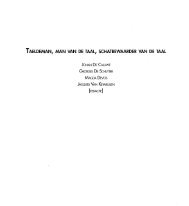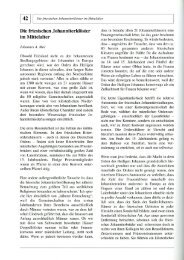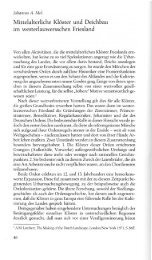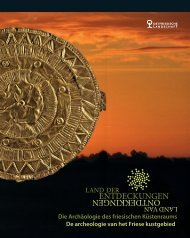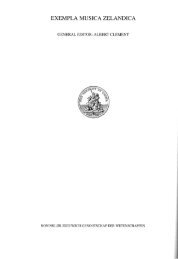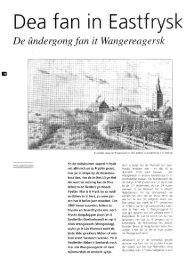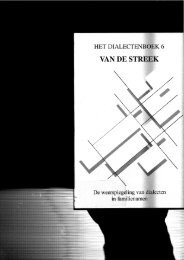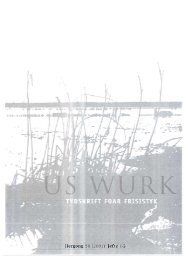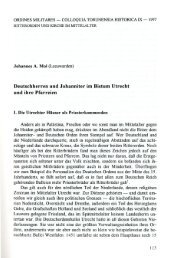Bernd Kortmann (ed.), Dialectology meets typology: Dialect ...
Bernd Kortmann (ed.), Dialectology meets typology: Dialect ...
Bernd Kortmann (ed.), Dialectology meets typology: Dialect ...
You also want an ePaper? Increase the reach of your titles
YUMPU automatically turns print PDFs into web optimized ePapers that Google loves.
LEONIE CORNIPS<br />
Ochs, Elinor (1996). Linguistic resources for socialising humanity. In J. Gumperz & S. Levinson<br />
(<strong>ed</strong>s.) Rethinking linguistic relativity, 438–69. Cambridge: Cambridge University Press.<br />
(Receiv<strong>ed</strong> 07 August 2007)<br />
Language in Society 37 (2008). Print<strong>ed</strong> in the Unit<strong>ed</strong> States of America<br />
doi:10.10170S0047404508080810<br />
<strong>Bernd</strong> <strong>Kortmann</strong> (<strong>ed</strong>.), <strong><strong>Dialect</strong>ology</strong> <strong>meets</strong> <strong>typology</strong>: <strong>Dialect</strong> grammar from a<br />
cross-linguistic perspective. (Trends in Linguistics.) Berlin & New York:<br />
Mouton de Gruyter, 2004. Pp. vi, 541. Hb $157.00.<br />
Review<strong>ed</strong> by Leonie Cornips<br />
Variation Linguistics, Meertens Institute<br />
Royal Netherlands Academy, Amsterdam, The Netherlands<br />
leonie.cornips@meertens.knaw.nl<br />
This volume is a collection of 18 papers, mainly arising from the workshop<br />
“<strong><strong>Dialect</strong>ology</strong> and Typology” organiz<strong>ed</strong> by <strong>Bernd</strong> <strong>Kortmann</strong> at the conference<br />
METHODS XI in Joensuu, Finland (5–9 August 2002). Ten of the contributors<br />
were invit<strong>ed</strong> speakers at this workshop and, according to the <strong>ed</strong>itor, the remaining<br />
eight “share a pronounc<strong>ed</strong> interest in looking across the fence which still<br />
separates dialectology and <strong>typology</strong>.” Typology in this volume is understood in<br />
functional terms in the Greenbergian tradition – that is, as the study of structural<br />
similarities between languages resulting from common design features and general<br />
properties of communicative systems (Muysken 2000: 263). The chapters<br />
are arrang<strong>ed</strong> in alphabetical order of the authors (Lieselotte Anderwald, Peter<br />
Auer, Raphael Berthele, Jack Chambers, Östen Dahl, Gunther de Vogelaer, Jürg<br />
Fleischer, <strong>Bernd</strong> <strong>Kortmann</strong>, Yaron Matras, Jim Miller, Günter Rohdenburg, Guido<br />
Seiler, Peter Siemund, Peter Trudgill, Johan van der Auwera & Annemie Neuckermans,<br />
Susanne Wagner, Björn Wiemer), although the volume starts out with<br />
the contribution by Walter Bisang in a nod to his integration of sociolinguistic<br />
models of diffusion with contact linguistics in <strong>typology</strong> and dialectology. In addition,<br />
there is a 10-page preface by the <strong>ed</strong>itor.<br />
The volume has a clear geographic and genetic bias with respect to the dialects<br />
and (non)standard varieties discuss<strong>ed</strong>: The overwhelming majority of the<br />
papers deal with contingent areas and induc<strong>ed</strong> language-contact situations in Europe.<br />
It discusses (morpho)syntactic phenomena of varieties of Baltic, Dutch,<br />
French German, Greek (sound changes), Romani, Scandinavian, and Slavic, in<br />
addition to English. As such, it is a convincing counterbalance to Chambers’s<br />
claim (142) that studies of vernaculars are virtually nonexistent for varieties other<br />
than English.<br />
The volume is very diverse in regard to the grammatical phenomena discuss<strong>ed</strong>,<br />
which include negation (Anderwald, van der Auwera & Neuckermans),<br />
complementation (Matras), complementizer agreement (De Vogelaer), clitic pronouns<br />
(Trudgill), resumptive pronouns (Rohdenburg), relative clauses and rela-<br />
604 Language in Society 37:4 (2008)
REVIEWS<br />
tivizers (Auer, Fleischer), and subject doubling (De Vogelaer), verb clusters<br />
(Seiler), pronominal reference (Wiemer), gender (Rohdenburg, Wagner, Wiemer),<br />
articles (Auer), agreement (Chambers, Wiemer), motion and posture verbs<br />
(Berthele), tense and aspect (<strong>Kortmann</strong>, Miller, Rohdenburg, Siemund), and doperiphrasis<br />
(Auer, <strong>Kortmann</strong>).<br />
Both the <strong>ed</strong>itor and the authors support the view that dialectology in an integrat<strong>ed</strong><br />
approach may benefit from the use of <strong>typology</strong> as a reference frame to<br />
study cross-dialectal and intradialectal variation in individual syntactic phenomena,<br />
whereas the use of dialect and nonstandard data in <strong>typology</strong> make it possible<br />
to formulate more fine-grain<strong>ed</strong> parameters, generalizations, and hierarchies.<br />
Let us begin by emphasizing that discussing this volume within the scope of<br />
one short review is doom<strong>ed</strong> to fail. It is impossible to do justice to each article in<br />
an appropriate way since they differ considerably with respect to the frameworks<br />
us<strong>ed</strong>, the concepts, and the analyses of the data. Rather than summarize<br />
and comment on each of the individual chapters, I will highlight themes that cut<br />
across the volume.<br />
To start with, this volume is extremely valuable for its reflection on the problematic<br />
aspects of the use of standard data in language-internal grammatical theories,<br />
be they functionalist or formalist. The volume as a whole expresses a strong<br />
ne<strong>ed</strong> to establish the empirical sources that can serve as crucial correctives for<br />
typological research (<strong>Kortmann</strong>, 2) and support claim<strong>ed</strong> generalizations and hierarchies<br />
at best (cf. Bresnan 2005). It is convincingly argu<strong>ed</strong> that in languageinternal<br />
grammatical theories relevant variation will be overlook<strong>ed</strong> when focusing<br />
exclusively on standard varieties (see Berthele, Bisang, <strong>Kortmann</strong>, Matras, Miller,<br />
Seiler, van der Auwera, and Neuckermans & Wagner) but, worse, this may also<br />
lead to an incorrect typological picture. Wagner (480) points out that while the<br />
Accessibility Hierarchy concerning relativization pr<strong>ed</strong>icts that gapping or zero<br />
relativization should be possible in subject position, it is not possible in standard<br />
(written) English but it is in English dialects. Similarly, Fleischer shows that<br />
standard German is fairly unrepresentative and even atypical compar<strong>ed</strong> to dialect<br />
varieties with respect to relative clause formation (236). It is even argu<strong>ed</strong> by<br />
Fleischer (237) that the <strong>typology</strong> of Standard Average European (SAE) looks so<br />
strange compar<strong>ed</strong> with the rest of the worlds’ languages because it is bas<strong>ed</strong> on<br />
standard languages.<br />
Further, a written standard may differ considerably from spoken standard<br />
varieties. Miller (310), for example, notes that in reference grammars standard<br />
English is usually present<strong>ed</strong> as having a prototypical Perfect, one structure with<br />
four major interpretations, including the experiential0indefinite anterior. But,<br />
as Miller argues, speakers and writers producing spontaneous UK standard<br />
speech frequently use the simple past combin<strong>ed</strong> with ever and never to express<br />
experiential0indefinite anterior. This has consequences, since any researcher<br />
comparing the classical prototypical perfect of standard English with nonstandard<br />
English varieties should also take the simple past into account.<br />
Language in Society 37:4 (2008) 605
LEONIE CORNIPS<br />
Milroy (2001:545) explains why written standard varieties do not always behave<br />
according to typological pr<strong>ed</strong>ictions. In a European context, functional and<br />
other formal theories that are bas<strong>ed</strong> on standard languages always imply an empirical<br />
base that is externally characteriz<strong>ed</strong> by numerous social and ideological<br />
criteria. Standard languages are us<strong>ed</strong> in writing; they have “<strong>ed</strong>ucat<strong>ed</strong>” status and<br />
literary functions. The most general assumptions condition<strong>ed</strong> by the standardlanguage<br />
ideology are that standard varieties are uniform in structure, that they<br />
are stable, and that they are finite-state entities. However, as Milroy (2001:545)<br />
suggests, these are not properties of “real” languages but properties of idealiz<strong>ed</strong><br />
states of languages. Probably it is this idealiz<strong>ed</strong> or “construct<strong>ed</strong>” state of a standard<br />
that explains why the linguistic conditioning of (written) standards is different<br />
than in the case of nonstandard varieties.<br />
Interestingly, in this volume two alternatives are present<strong>ed</strong> to avoid as much<br />
as possible bringing typological inaccuracies along with the selection of a standard<br />
variety. First, it is possible to choose a variety that has no standard and0or<br />
globally accept<strong>ed</strong> prestige dialect and is an oral variety for the great majority of<br />
speakers, as Matras discusses for Romani (279). Second, Auer’s exploration (see<br />
also Berthele) of which type of data is the most accurate for syntactic typologies<br />
and generalizations is extremely important. It is suggest<strong>ed</strong> that analysts select<br />
those syntactic features that have a wide areal distribution and do not belong to<br />
the written and oral standard variety – the so-call<strong>ed</strong> nonstandard, nondialectal<br />
features. Examples include double negation and periphrastic do, which occur<br />
throughout the German area (and cross national borders too, since these constructions<br />
also appear in non-spoken standard in the Netherlands and Belgium (Barbiers<br />
et al. 2002)). In contrast, dialect features with a restrict<strong>ed</strong> areal reach may<br />
in fact constitute idiosyncrasies that do not contribute to a typological perspective<br />
on, for instance, German as a whole (whereas they are of course relevant for<br />
any linguistic theory). Moreover, Auer emphasizes the importance of keeping<br />
separate the structural consequences of orality, such as prolepsis, elliptic constructions,<br />
and congruence violations, from geographically restrict<strong>ed</strong> syntactic<br />
features. Also, Cheshire 2005 argues that the way speakers use the forms of spoken<br />
language may result as much from interactional and social factors as from<br />
syntax, and typologists ne<strong>ed</strong> to come to a principl<strong>ed</strong> decision about whether such<br />
forms should be seen as generat<strong>ed</strong> by the grammar or attribut<strong>ed</strong> to performance<br />
mechanisms.<br />
This volume is also extremely valuable in that it convincingly reveals that<br />
“the present-day political borders between the countries do not correspond well<br />
to the internal structure of the dialect continuum and the diversity within the<br />
countries may be greater than the differences between the national standards”<br />
(Dahl, 159).<br />
There are three issues I would like to address, however. The first issue is that<br />
concepts like simplification0complexification, (un)mark<strong>ed</strong>ness, and (un)naturalistic<br />
tendencies play a very important role in the theoretical analyses in several<br />
606 Language in Society 37:4 (2008)
REVIEWS<br />
contributions in this volume, but their definitions are left implicit and the authors’<br />
attitudes remain unclear (with the exception of Anderwald, 48; cf. Kusters<br />
2003:1–17). These concepts are extremely complicat<strong>ed</strong> and well found<strong>ed</strong> from<br />
the perspective of functional grammar, but without explicit characterizations a<br />
precise insight into their explanatory adequacy is impossible.<br />
Second, why did it take so long to include nonstandard0dialect data in <strong>typology</strong><br />
(or other formal theories)? The reason for exclusion cannot be a grammatical<br />
one, since structural differences between a dialect and a relat<strong>ed</strong> language are<br />
of the same nature as differences between two relat<strong>ed</strong> languages. This is so because<br />
the question of what makes a “dialect” and what makes a “language” is not<br />
linguistically motivat<strong>ed</strong> but rather social in nature (Bisang, 13). Bisang (25)<br />
doesn’t exclude a priori the existence of major structural differences between<br />
closely relat<strong>ed</strong> varieties. Inde<strong>ed</strong>, many authors in this volume show that dialects<br />
may differ in many (sometimes surprising) respects from the standard variety.<br />
One answer might simply be the shortage of morphosyntactic dialect data available<br />
for typological research, since it was a neglect<strong>ed</strong> topic in dialectology in the<br />
past (Barbiers et al. 2002, Cornips & Poletto 2005). Nevertheless, computeriz<strong>ed</strong><br />
storage of spoken-dialect morphosyntactic data with annotation and retrieval has<br />
become available recently, and two such databases are drawn on in this volume:<br />
the Freiburg English <strong>Dialect</strong> corpus (FRED) (Anderwald) and the Romani Morphosyntactic<br />
database (RMS) (Matras). (See also the Syntactic Atlas of the Dutch<br />
<strong>Dialect</strong>s, SAND; Barbiers et al. 2007.) It is a pity that some authors in this volume<br />
still concentrate their research on traditional dialect grammars and other<br />
(written) descriptions of very local dialect varieties (in the past).<br />
The final issue concerns the notion of inherent variability. Although the empirical<br />
base in this volume is constitut<strong>ed</strong> of dialect and nonstandard varieties<br />
rather than standard varieties, there is no mention or focus on variability within<br />
the grammars. It is, of course, an important empirical and theoretical question<br />
whether we consider nonstandard varieties in contemporary Western communities<br />
as homogeneous and stable, since they rarely exist nowadays in absolute<br />
isolation. Inde<strong>ed</strong>, most competent speakers of dialects and nonstandard varieties<br />
can resort to a range of varieties along a continuum from standard to nonstandard,<br />
and stylistically from more formal to less formal, depending on social and<br />
discourse contexts (cf. Cornips & Corrigan 2005). In addition, dialect speakers<br />
may be rais<strong>ed</strong> “bilingually” from birth in the local dialect and a supralocal variety,<br />
thus being, in effect, simultaneous L1 acquirers. In my view, issues as these<br />
should be a focus for further investigation and research.<br />
In sum, this book is admirable for its ambition to answer the ultimate question<br />
that the inclusion of dialects in European areal <strong>typology</strong> might answer: “what<br />
the ‘real’, i.e. spoken non-standard, landscape of Europe looks like” (<strong>Kortmann</strong>,<br />
6). It is certain that many readers will be inspir<strong>ed</strong> by the wealth of carefully<br />
present<strong>ed</strong> data and thoughtfully argu<strong>ed</strong> work to embark on such (international)<br />
projects.<br />
Language in Society 37:4 (2008) 607
CHARLES ANTAKI<br />
REFERENCES<br />
Barbiers, Sjef; Cornips, Leonie; & Kunst, Jan-Pieter (2007). The syntactic atlas of the Dutch dialects:<br />
A corpus of elicit<strong>ed</strong> speech and text as an on-line dynamic atlas. In Joan C. Beal, Karen C.<br />
Corrigan, & Hermann L. Moisl (<strong>ed</strong>s.), Creating and digitizing language corpora. Volume 1: Synchronic<br />
databases, 54–90. Hampshire: Palgrave Macmillan.<br />
_;_; & Van der Kleij, Suzanne (<strong>ed</strong>s.) (2002). Syntactic microvariation. Electronic publication<br />
of the Meertens Institute, http:00www.meertens.knaw.nl0projecten0sand0synmic0 Amsterdam:<br />
Meertens Institute.<br />
Bresnan, Joan (2005). A few lessons from <strong>typology</strong>. In Comments from the LSA Workshop: Typology<br />
in American Linguistics. An Appraisal of the Field. LSA 79th Annual Meeting, Oakland,<br />
January 9.<br />
Cheshire, Jenny (2005). Syntactic variation and spoken language. In Leonie Cornips & Karen P.<br />
Corrigan (<strong>ed</strong>s.), Syntax and variation: Reconciling the biological with the social, 81–106. Amsterdam<br />
& Philadelphia: John Benjamins.<br />
Cornips, Leonie, & Corrigan, Karen P. (<strong>ed</strong>s.) (2005). Syntax and variation: Reconciling the biological<br />
with the social. Amsterdam & Philadelphia: John Benjamins.<br />
_, & Poletto, Cecilia (2005). On standardising syntactic elicitation techniques. Part I. Lingua<br />
115:939–57.<br />
Kusters, Wouter (2003.) Linguistic complexity: The influence of social change on verbal inflection.<br />
Dissertation, University of Leiden.<br />
Milroy, James (2001). Language ideologies and the consequences of standardization. Journal of<br />
Sociolinguistics 5:530–55<br />
Muysken, Pieter (2000). From linguistic areas to areal linguistics: a research proposal. In Dicky<br />
Gilbers, John Nerbonne & Jos Schaeken (<strong>ed</strong>s.) Languages in contact, 263–76. Amsterdam & Atlanta:<br />
Rodopi.<br />
(Receiv<strong>ed</strong> 14 August 2007)<br />
Language in Society 37 (2008). Print<strong>ed</strong> in the Unit<strong>ed</strong> States of America<br />
doi:10.10170S0047404508080822<br />
Emanuel A. Schegloff, Sequence organization in interaction: A primer in<br />
conversation analysis, volume 1. Cambridge, UK: Cambridge University Press,<br />
2007. Pp. xvi, 316. Hb $104.00.<br />
Review<strong>ed</strong> by Charles Antaki<br />
Discourse and Rhetoric Group<br />
Department of Social Sciences<br />
Loughborough University, UK<br />
c.antaki@Lboro.ac.uk<br />
How is conversation organiz<strong>ed</strong>? This book, the first in a plann<strong>ed</strong> series of “primers”<br />
by an author who is arguably Conversation Analysis’s (CA) most authoritative<br />
exponent, explains in microscopic detail how speakers bring off the sequences<br />
of turns that organize their conversation, and thereby prosecute their business<br />
with each other.<br />
We start with CA’s most protean unit, the simple adjacency pair (an utterance<br />
imm<strong>ed</strong>iately respond<strong>ed</strong> to by the class of utterance it projects, e.g., Whatcha<br />
doin? Nuthin’), and we end up with large sequences, over many turns at talk per<br />
speaker, as they segue from one to the other (a greeting sequence licenses a move<br />
to topic; a story prompts a second story; and so on). We are in a landscape where<br />
608 Language in Society 37:4 (2008)



